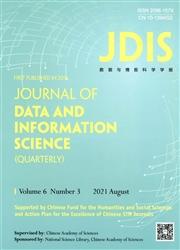Research evolution of metal organic frameworks: A scientometric approach with human-in-the-loop
IF 1.5
3区 管理学
Q2 INFORMATION SCIENCE & LIBRARY SCIENCE
引用次数: 0
Abstract
Purpose This paper reports on a scientometric analysis bolstered by human-in-the-loop, domain experts, to examine the field of metal-organic frameworks (MOFs) research. Scientometric analyses reveal the intellectual landscape of a field. The study engaged MOF scientists in the design and review of our research workflow. MOF materials are an essential component in next-generation renewable energy storage and biomedical technologies. The research approach demonstrates how engaging experts, via human-in-the-loop processes, can help develop a comprehensive view of a field’s research trends, influential works, and specialized topics. Design/methodology/approach A scientometric analysis was conducted, integrating natural language processing (NLP), topic modeling, and network analysis methods. The analytical approach was enhanced through a human-in-the-loop iterative process involving MOF research scientists at selected intervals. MOF researcher feedback was incorporated into our method. The data sample included 65,209 MOF research articles. Python3 and software tool金属有机框架的研究演变:以人为本的科学计量学方法
目的 本文报告了一项科学计量分析,该分析得到了在环人类、领域专家的支持,对金属有机框架(MOFs)研究领域进行了考察。科学计量分析揭示了一个领域的知识状况。这项研究让 MOF 科学家参与了我们研究工作流程的设计和审查。MOF 材料是下一代可再生能源储存和生物医学技术的重要组成部分。该研究方法展示了如何通过 "人在回路中 "的流程让专家参与进来,从而帮助全面了解一个领域的研究趋势、有影响力的作品和专业课题。设计/方法/途径 结合自然语言处理(NLP)、主题建模和网络分析方法,进行了科学计量学分析。在选定的时间间隔内,通过有 MOF 研究科学家参与的人为循环迭代过程,对分析方法进行了改进。MOF 研究人员的反馈意见被纳入到我们的方法中。数据样本包括 65209 篇 MOF 研究文章。使用 Python3 和软件工具 VOSviewer 进行分析。研究结果 研究结果表明,让领域专家参与研究工作流程、改进和结果解释具有重要价值。在分析的每个阶段,MOF 研究人员都参与了对结果的解释,并针对我们对 MOF 研究的关注点对方法进行了改进。本研究确定了有影响力的作品及其主题。我们的研究结果还强调了 MOF 的四个主要研究方向和应用。研究局限性 本研究受限于为我们的分析提供信息的样本(由剑桥结构数据库确定和引用的文章)。实际意义 我们的研究结果有助于弥补目前在全面描绘 MOF 研究全貌方面的不足。此外,这些结果还有助于领域科学家确定未来的研究方向。原创性/价值 据我们所知,为分析而收集的出版物数量超过了以往的研究。与以往的研究相比,这使我们能够探索更广泛的 MOF 研究。我们工作的另一个贡献是领域科学家的反复参与,他们为数据分析带来了深入的专业解读,帮助完善了研究。
本文章由计算机程序翻译,如有差异,请以英文原文为准。
求助全文
约1分钟内获得全文
求助全文
来源期刊

Journal of Data and Information Science
INFORMATION SCIENCE & LIBRARY SCIENCE-
CiteScore
3.50
自引率
6.70%
发文量
495
期刊介绍:
JDIS devotes itself to the study and application of the theories, methods, techniques, services, infrastructural facilities using big data to support knowledge discovery for decision & policy making. The basic emphasis is big data-based, analytics centered, knowledge discovery driven, and decision making supporting. The special effort is on the knowledge discovery to detect and predict structures, trends, behaviors, relations, evolutions and disruptions in research, innovation, business, politics, security, media and communications, and social development, where the big data may include metadata or full content data, text or non-textural data, structured or non-structural data, domain specific or cross-domain data, and dynamic or interactive data.
The main areas of interest are:
(1) New theories, methods, and techniques of big data based data mining, knowledge discovery, and informatics, including but not limited to scientometrics, communication analysis, social network analysis, tech & industry analysis, competitive intelligence, knowledge mapping, evidence based policy analysis, and predictive analysis.
(2) New methods, architectures, and facilities to develop or improve knowledge infrastructure capable to support knowledge organization and sophisticated analytics, including but not limited to ontology construction, knowledge organization, semantic linked data, knowledge integration and fusion, semantic retrieval, domain specific knowledge infrastructure, and semantic sciences.
(3) New mechanisms, methods, and tools to embed knowledge analytics and knowledge discovery into actual operation, service, or managerial processes, including but not limited to knowledge assisted scientific discovery, data mining driven intelligent workflows in learning, communications, and management.
Specific topic areas may include:
Knowledge organization
Knowledge discovery and data mining
Knowledge integration and fusion
Semantic Web metrics
Scientometrics
Analytic and diagnostic informetrics
Competitive intelligence
Predictive analysis
Social network analysis and metrics
Semantic and interactively analytic retrieval
Evidence-based policy analysis
Intelligent knowledge production
Knowledge-driven workflow management and decision-making
Knowledge-driven collaboration and its management
Domain knowledge infrastructure with knowledge fusion and analytics
Development of data and information services
 求助内容:
求助内容: 应助结果提醒方式:
应助结果提醒方式:


